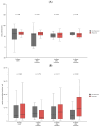Extracellular Vesicles May Predict Response to Atezolizumab Plus Bevacizumab in Patients with Advanced Hepatocellular Carcinoma
- PMID: 39518089
- PMCID: PMC11545167
- DOI: 10.3390/cancers16213651
Extracellular Vesicles May Predict Response to Atezolizumab Plus Bevacizumab in Patients with Advanced Hepatocellular Carcinoma
Abstract
Background and aims: Treatment with atezolizumab and bevacizumab has been approved as one of the standards of care for patients with advanced hepatocellular carcinoma (HCC). The median overall survival (OS) upon available treatments still remains below 2 years, urgently suggesting better stratification tools to identify ideal candidates for this treatment and potentially allowing personalized approaches. In this study, we evaluated the potential role of extracellular vesicles (EVs) as a novel biomarker in patients receiving atezolizumab and bevacizumab for HCC.
Methods: We characterized EVs in 212 longitudinal serum samples from an observational cohort of 53 individuals with advanced HCC, who started therapy with atezolizumab plus bevacizumab at our center between January 2020 and March 2022.
Results: In our cohort, the overall efficacy of atezolizumab and bevacizumab was comparable to previously published phase III data. We detected significantly smaller EVs in treatment responders, while enlarged EVs were associated with significantly decreased efficacy of atezolizumab and bevacizumab in terms of OS. A decrease in vesicle size during immunotherapy was related to a longer progression-free survival (PFS). A univariate Cox regression analysis including various clinicopathological parameters (e.g., tumor stage, markers of inflammation, organ dysfunction, or tumor markers) revealed vesicle size as an independent prognostic marker in HCC patients receiving atezolizumab and bevacizumab. Moreover, higher vesicle concentrations and lower zeta potentials were identified as a positive prognostic factor throughout treatment.
Conclusions: Distinct EV characteristics such as vesicle size, concentration, and zeta potential represent promising novel biomarkers in patients with advanced HCC receiving atezolizumab and bevacizumab, potentially helping to identify optimal candidates for checkpoint inhibitor-based treatments.
Keywords: atezolizumab; bevacizumab; extracellular vesicles; hepatocellular carcinoma (HCC); immunotherapy; prognostic biomarker.
Conflict of interest statement
The authors disclose no conflicts of interest.
Figures



References
-
- Reig M., Forner A., Rimola J., Ferrer-Fabrega J., Burrel M., Garcia-Criado A., Kelley R.K., Galle P.R., Mazzaferro V., Salem R., et al. BCLC strategy for prognosis prediction and treatment recommendation: The 2022 update. J. Hepatol. 2022;76:681–693. doi: 10.1016/j.jhep.2021.11.018. - DOI - PMC - PubMed
-
- Finn R.S., Bentley G., Britten C.D., Amado R., Busuttil R.W. Targeting vascular endothelial growth factor with the monoclonal antibody bevacizumab inhibits human hepatocellular carcinoma cells growing in an orthotopic mouse model. Liver Int. 2009;29:284–290. doi: 10.1111/j.1478-3231.2008.01762.x. - DOI - PubMed
LinkOut - more resources
Full Text Sources

